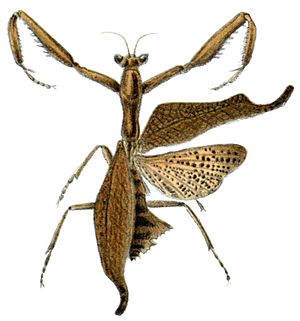Decimiana hebardi facts for kids
Quick facts for kids Decimiana hebardi |
|
|---|---|
 |
|
| Scientific classification |
Decimiana hebardi is a special kind of praying mantis. It belongs to the Acanthopidae family. This insect was first described in the year 2000 by a scientist named Lombardo. Like other praying mantises, Decimiana hebardi is a fascinating predator. It uses its unique front legs to catch other insects.
Contents
What is a Praying Mantis?
Praying mantises are amazing insects. They are known for their distinctive posture. Their front legs are folded as if they are praying. This posture helps them stay still. It also helps them ambush their prey. Mantises are found all over the world. They live in many different habitats. These include forests, grasslands, and even deserts.
Body Features of a Mantis
Mantises have a long body. They also have a triangular head. This head can turn almost 180 degrees. This helps them see all around. They have two large compound eyes. These eyes are great for spotting movement. They also have three simple eyes. These are called ocelli. They help them detect light.
Special Front Legs
The most famous part of a mantis is its front legs. These legs are very strong. They have sharp spines on them. When a mantis catches prey, these spines help hold it tight. The legs snap shut very quickly. This makes it hard for prey to escape. This is why they are such good hunters.
Where Do Mantises Live?
Most mantises prefer warm climates. They are often found in tropical and subtropical regions. They like places with lots of plants. This helps them hide from predators. It also helps them sneak up on their prey. Some mantises live in trees. Others live in tall grasses.
Camouflage Masters
Mantises are masters of disguise. Many species blend in perfectly with their surroundings. Some look like leaves. Others look like twigs or flowers. This camouflage helps them hide. It protects them from birds and lizards. It also helps them surprise their insect meals.
What Do Mantises Eat?
Praying mantises are carnivores. This means they eat other animals. Their diet mainly consists of insects. They love to eat flies, moths, and crickets. Some larger mantises can even catch small lizards or frogs. They are very important for controlling insect populations.
How They Hunt
A mantis waits patiently for its prey. It stays perfectly still. When an unsuspecting insect comes close, the mantis strikes. Its front legs shoot out incredibly fast. The prey is caught in a vice-like grip. The mantis then eats its meal. It usually starts with the head.
Life Cycle of a Mantis
The life of a praying mantis is fascinating. It goes through several stages.
Eggs and Nymphs
Female mantises lay their eggs in a special case. This case is called an ootheca. It is made of a foamy substance. The ootheca hardens and protects the eggs. It is often attached to a twig or a wall. When the eggs hatch, tiny mantis nymphs emerge. These nymphs look like small versions of adult mantises.
Growing Up
The nymphs grow by shedding their skin. This process is called molting. They molt several times as they get bigger. Each time they molt, they grow larger. They also become more like an adult mantis. This stage can take several weeks or months. It depends on the species and the environment.
Adult Mantis
Once a mantis reaches its adult stage, it has wings. It is also ready to reproduce. Adult mantises usually live for a few months. Their main goal is to find a mate. They then lay eggs to start the cycle again.
See also
 In Spanish: Decimiana hebardi para niños
In Spanish: Decimiana hebardi para niños
- List of mantis genera and species

